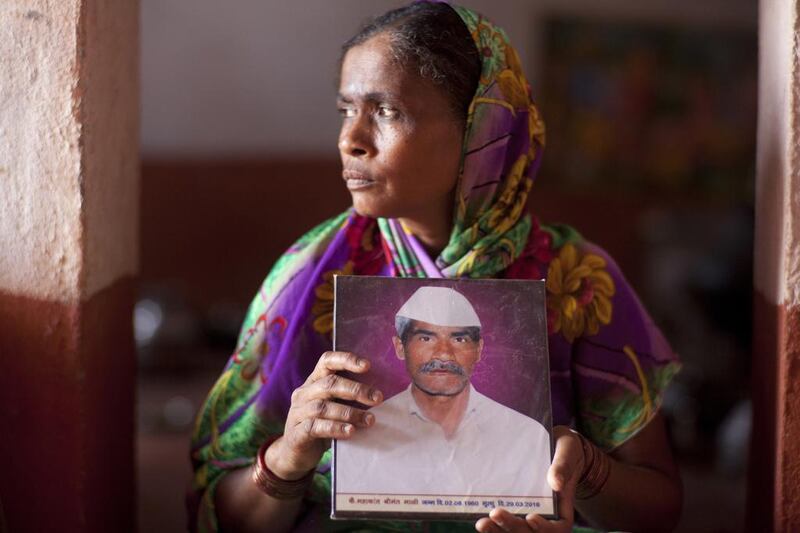LATUR, INDIA // Mahakant Mali hanged himself from a mango tree a short distance from his farm a few weeks ago, a victim of the severe drought affecting central India.
Mali’s soya bean crop had withered away and he had racked up loans of 150,000 rupees (Dh8,265) as he bored wells to find water in Maharashtra state.
On a Monday evening, the 55-year-old told his wife he was going to meet a friend and did not return. A child discovered his body the following morning.
“What can I do?” says his widow Kamalbai at their home in Gategaon, one of 943 villages in Maharashtra’s Latur district.
Latur is part of the state’s predominantly agricultural Marathwada region, where 273 farmers committed suicide between January and March this year.
The area is among the worst affected by the drought and some families in Latur have left for cities such as the state capital Mumbai, nearly 500 kilometres away. In Latur town, there are huge queues at water storage tanks that are fed from dams. People wait in the searing heat for hours, sometimes the entire day, to fill up their containers. Police guard some of the tanks to prevent fights.
Water is also being supplied to Latur by rail, with two 50-wagon trains arriving last week. The water is first taken to a filtration plant before being distributed across the town by lorry.
The Indian government says about 330 million people in 10 states are affected by the drought, which has been blamed on two consecutive years of poor monsoon rainfall. Adding to their misery, temperatures are above 40°C – unusually high for the time of year.
Widespread production of sugar cane, a water intensive crop, in Maharashtra’s Marathwada region, which includes the districts of Latur, Beed and Osmanabad, is also widely blamed for draining water resources.
“The priority is drinking water and getting food grains to the people,” says Saqueb Osmani, the disaster management officer at Latur’s district administration office, which has set up a war room to tackle the crisis. There have been “many” farmer suicides in the wake of crops failing in recent months, he adds.
“There’s a social impact, environmental impact. Some people are angry.”
He says authorities have cut off water supply to industries in the area, which some locals accuse of draining water resources.
“The poor don’t get water because it all goes to the rich who are into sugar cane and industry,” says Padmakar Kathwate, 37, who runs a small restaurant in Latur. “People play politics over water but that’s the real reason. Nobody cares about us.”
He says he has not received any of the water brought into Latur by train.
Harish Chandra Shinde, 48, says this is the worst drought he has experienced in 30 years of farming.
“All my crops have died,” says Mr Shinde, who farms four hectares in Talegaon, about 40 kilometres from Latur town.
He also owes 250,000 rupees of loans he had taken to buy seeds, fertiliser and pesticides, but he tries to remain optimistic.
“I’ll manage,” he says.
Balasahab Kale, 60, has walked his water buffalo more than a kilometre to drink from a pool of soapy green water – all that remains of a river.
“I can’t sleep through the night because of the water situation,” says Mr Kale, who farms two acres of land in Sai, outside of Latur town. “If a guest comes to the house, we cannot offer them a drink of water because there is so much scarcity. People are even postponing their weddings because of the water crisis.”
Milind Potdar, a psychiatrist in Latur, has been researching the growing problem of farmer suicides in the district and says the drought has certainly been a trigger in a number of cases.
He started a toll-free helpline three months ago for the “psychologically distressed” which has already received more than 800 calls, about half of them from farmers.
Mr Osmani, the disaster management official, says authorities are working on rain harvesting, digging wells and creating water-storage solutions to tackle the problem in the long term.
For now though, the state government helping farmers by restructuring loans and giving rebates on electricity bills. “We have taken lots of efforts,” he says.
In Gategaon, the elder two of Mali’s three sons now work as labourers at a dam site earning 200 rupees a day.
The middle son, Ravikant, 21, says he hopes the monsoons that usually arrive in the area each June will bring better rainfall this year.
“We are waiting for the rains to come,” he says. “When the rains come, we’ll go and work on the farm.”
foreign.desk@thenational.ae





